A Meta-Analysis on the Effect of Expertise on Eye Movements during Music Reading
Abstract
:Introduction
Expertise in music reading
Eye tracking in music reading
Eye-movement variables
Fixation measures
Saccade measures
Eye movements in musical expertise
Moderators of the effect of musical expertise in music reading
The present study
Methods
Search protocol
Inclusion Criteria
Coding procedure and potential moderators
Analyses
Computation of weighted mean effect size
Heterogeneity and publication bias assessment
Results
Subset 1: Fixation duration
Subset 2: Number of fixations
Subset 3: Saccade amplitude
Subset 4: Gaze duration
General study characteristics
Effect size analyses
Subset 1: Fixation duration
Subset 2: Number of fixations
Subset 3: Saccade amplitude - Subset 4: Gaze duration - Moderator analyses
Discussion
The effect of musical expertise on eye-movement metrics
Connecting musical expertise to theories of visual expertise
Limitations
Recommendations for further directions
Ethics and Conflict of Interest
Acknowledgement
Appendices
Appendix A. Effect size calculations
- 1)
- When only standard error se was available, standard deviation sd was calculated as:

- 2)
- Cohen’ s d was computed as:



- 3)
- The standard error of the effect size for a between-subjects design was computed as:

- 4)
- For small samples, Cohen’s d might produce an overestimate of true effect size. Thus, we calculated Hedges’s g for each of the included effect sizes in order to correct for this bias. The following formula was used (Hedges & Olkin, 1985; Hedges et al., 2010):

Appendix B. Sensitivity analyses for the fixation duration

Appendix C. Sensitivity analyses for the number of fixations

References
- References marked with an asterisk indicate studies included in the meta-analysis.
- Abernethy, B., D. Farrow, and D. L. Mann. 2018. Superior anticipation. In The Cambridge handbook of expertise and expert performance, 2nd ed. Cambridge University Press: pp. 677–695. [Google Scholar] [CrossRef]
- Ahken, S., G. Comeau, S. Hébert, and R. Balasubramaniam. 2012. Eye movement patterns during the processing of musical and linguistic syntactic incongruities. Psychomusicology: Music, Mind, and Brain 22, 1: 18–25. [Google Scholar] [CrossRef]
- Angeli, F, G Reboldi, M Trapasso, G Santilli, M Zappa, and P. Verdecchia. Blood Pressure Increase following COVID-19 Vaccination: A Systematic Overview and Meta-Analysis. J Cardiovasc Dev Dis 9, 5: 150. [CrossRef]
- Arthur, J., M. Waring, R. Coe, and L. V. Hedges. 2012. Research Methods and Methodologies in Education. Los Angeles: Sage. [Google Scholar]
- * Arthur, P., D. Blom, and S. Khuu. 2016. Music sightreading expertise, visually disrupted score and eye movements. Journal of Eye Movement Research 9, (7):1: 1–12. [Google Scholar] [CrossRef]
- Bilalić, M. 2018. The double take of expertise: Neural expansion is associated with outstanding performance. Current Directions in Psychological Science 27, 6: 462–469. [Google Scholar] [CrossRef]
- Borenstein, M., L. V. Hedges, J. P. T. Higgins, and H. R. Rothstein. 2009. Introduction to Meta-Analysis. John Wiley & Sons, Ltd. [Google Scholar] [CrossRef]
- Borenstein, M., J. P. T. Higgins, L. V. Hedges, and H. R. Rothstein. 2017. Basics of meta-analysis: I2 is not an absolute measure of heterogeneity. Research Synthesis Methods 8, 1: 5–18. [Google Scholar] [CrossRef] [PubMed]
- Brams, S., G. Ziv, O. Levin, J. Spitz, J. Wagemans, A. M. Williams, and W. F. Helsen. 2019. The relationship between gaze behavior, expertise, and performance: A systematic review. Psychological Bulletin, 145, 10, 980–1027. [Google Scholar] [CrossRef]
- Burman, D. D., and J. R. Booth. 2009. Music rehearsal increases the perceptual span for notation. Music Perception 26, 4: 303–320. [Google Scholar] [CrossRef]
- Casanova, F., J. Garganta, G. Silva, A. Alves, J. Oliveira, and A.M. Williams. 2013. Effects of prolonged intermittent exercise on perceptual-cognitive processes. Medicine and Science in Sports and Exercise 45, 8: 1610–1617. [Google Scholar] [CrossRef]
- Chaffin, R., and G. Imreh. 1997. “Pulling teeth and torture”: Musical memory and problem solving. Thinking & Reasoning 3, 4: 315–336. [Google Scholar] [CrossRef]
- Chase, W. G., and H. A. Simon. 1973. Perception in chess. Cognitive Psychology 4, 1: 55–81. [Google Scholar] [CrossRef]
- Cohen, J. 1992. A power primer. Psychological Bulletin 112, 1: 155–159. [Google Scholar] [CrossRef] [PubMed]
- Cohen, J. 1977. Statistical power analysis for the behavioral sciences. Lawrence Erlbaum Associates, Inc. [Google Scholar]
- Delgado, P., C. Vargas, R. Ackerman, and L. Salmerón. 2018. Don’t throw away your printed books: A metaanalysis on the effects of reading media on reading comprehension. In Educational Research Review. Elsevier Ltd. [Google Scholar] [CrossRef]
- Delmas, M., L. Caroux, and C. Lemercier. 2022. Searching in clutter: Visual behavior and performance of expert action video game players. Applied Ergonomics 99: 103628. [Google Scholar] [CrossRef] [PubMed]
- * Drai-Zerbib, V., and T. Baccino. 2005. L’expertise dans la lecture musicale: Intégration intermodale. L’année Psychologique 105, 3: 387–422. [Google Scholar] [CrossRef]
- * Drai-Zerbib, V., and T. Baccino. 2014. The effect of expertise in music reading: Cross-modal competence. Journal of Eye Movement Research 6, (5):5: 1–10. [Google Scholar]
- * Drai-Zerbib, V., and T. Baccino. 2018. Cross-modal music integration in expert memory: Evidence from eye movements. Journal of Eye Movement Research 11, 2: 4. [Google Scholar] [CrossRef]
- * Drai-Zerbib, V., T. Baccino, and E. Bigand. 2012. Sight-reading expertise: Cross-modality integration investigated using eye tracking. Psychology of Music 40, 2: 216–235. [Google Scholar] [CrossRef]
- Duchowski, A. 2007. Edited by A. Duchowski. Eye movement analysis. In Eye tracking methodology: Theory and practice. Springer: pp. 137–153. [Google Scholar] [CrossRef]
- Ericsson, K. A., and W. Kintsch. 1995. Long-term working memory. Psychological Review 102, 2: 211–245. [Google Scholar] [CrossRef]
- Fink, L. K., E. B. Lange, and R. Groner. 2018. The application of eye-tracking in music research. Journal of Eye Movement Research 11, (2):1: 1–4. [Google Scholar] [CrossRef]
- Fisher, Z., and E. Tipton. 2015. robumeta: An R-package for robust variance estimation in meta-analysis. ArXiv:1503.02220 [Stat]. http://arxiv.org/abs/1503.02220.
- Furneaux, S., and M. F. Land. 1999. The effects of skill on the eye–hand span during musical sight–reading. Proceedings of the Royal Society of London. Series B: Biological Sciences 266, 1436: 2435–2440. [Google Scholar] [CrossRef]
- Gegenfurtner, A., E. Lehtinen, and R. Säljö. 2011. Expertise differences in the comprehension of visualizations: A meta-analysis of eye-tracking research in professional domains. Educational Psychology Review 23, 4: 523–552. [Google Scholar] [CrossRef]
- Gilman, E., and G. Underwood. 2003. Restricting the field of view to investigate the perceptual spans of pianists. Visual Cognition 10, 2: 201–232. [Google Scholar] [CrossRef]
- Gobet, F. 2005. Chunking models of expertise: Implications for education. Applied Cognitive Psychology 19, 2: 183–204. [Google Scholar] [CrossRef]
- Gobet, F., and H. A. Simon. 1996. Templates in chess memory: A mechanism for recalling several boards. Cognitive Psychology 31, 1: 1–40. [Google Scholar] [CrossRef]
- Gobet, F., and H. A. Simon. 2000. Five seconds or sixty? Presentation time in expert memory. Cognitive Science 24, 4: 651–682. [Google Scholar] [CrossRef]
- Goldberg, J. H., and J. C. Schryver. 1995. Eye-gaze-contingent control of the computer interface: Methodology and example for zoom detection. Behavior Research Methods, Instruments, & Computers 27, 3: 338–350. [Google Scholar] [CrossRef]
- Goldberg, J. H., and A. M. Wichansky. 2003. Edited by J. Hyönä, R. Radach and H. Deubel. Chapter 23 Eye tracking in usability evaluation: A practitioner’s guide. In The Mind’s Eye. North-Holland: pp. 493–516. [Google Scholar] [CrossRef]
- Goldberg, M. E., J. Bisley, K. D. Powell, J. Gottlieb, and M. Kusunoki. 2002. The role of the lateral intraparietal area of the monkey in the generation of saccades and visuospatial attention. Annals of the New York Academy of Sciences 956, 1: 205–215. [Google Scholar] [CrossRef] [PubMed]
- * Goolsby, T. W. 1994a. Eye Movement in Music Reading: Effects of Reading Ability, Notational Complexity, and Encounters. Music Perception: An Interdisciplinary Journal 12, 1: 77–96. [Google Scholar] [CrossRef]
- Goolsby, T. W. 1994b. Profiles of processing: Eye movements during sightreading. Music Perception 12, 1: 97–123. [Google Scholar] [CrossRef]
- Griffin, Z. M., and D. H. Spieler. 2006. Observing the what and when of language production for different age groups by monitoring speakers’ eye movements. Brain and Language 99, 3: 272–288. [Google Scholar] [CrossRef]
- Hadley, L. V., P. Sturt, T. Eerola, and M. J. Pickering. 2017. Incremental comprehension of pitch relationships in written music: Evidence from eye movements. Quarterly Journal of Experimental Psychology 71, 1: 211–219. [Google Scholar] [CrossRef]
- Haider, H., and P. A. Frensch. 1999. Eye movement during skill acquisition: More evidence for the information-reduction hypothesis. Journal of Experimental Psychology: Learning, Memory, and Cognition 25, 1: 172–190. [Google Scholar] [CrossRef]
- Harrer, M., P. Cuijpers, T. Furukawa, and D.D. Ebert. 2021. Doing Meta-Analysis in R: A Hands-on Guide. Available online: https://bookdown.org/MathiasHarrer/Doing_Meta_Analysis_in_R/.
- Hedges, L. V., and I. Olkin. 1985. Statistical Methods for Meta-Analysis. Academic Press. [Google Scholar]
- Hedges, L. V., E. Tipton, and M. C. Johnson. 2010. Robust variance estimation in meta-regression with dependent effect size estimates. Research Synthesis Methods 1: 39–65. [Google Scholar] [CrossRef] [PubMed]
- Hempel, S., J. N. Miles, M. J. Booth, Z. Wang, S. C. Morton, and P. G. Shekelle. 2013. Risk of bias: A simulation study of power to detect study-level moderator effects in meta-analysis. Systematic Reviews 2, 1: 107. [Google Scholar] [CrossRef]
- Hicken, L. K. 2019. Analyses of gaze in music tasks: Score reading and observations of instrumental performance [Thesis]. [Google Scholar] [CrossRef]
- Higgins, J. P. T., S. G. Thompson, J. J. Deeks, and D. G. Altman. 2003. Measuring inconsistency in meta-analyses. British Medical Journal 327, 7414: 557–560. [Google Scholar] [CrossRef] [PubMed]
- Holmqvist, K., M. Nyström, R. Andersson, R. Dewhurst, J. Halszka, and J. Van de Weijer. 2011. Eye tracking: A comprehensive guide to methods and measures. Oxford University Press. [Google Scholar]
- Hosp, B. W., F. Schultz, O. Höner, and E. Kasneci. 2021. Soccer goalkeeper expertise identification based on eye movements. PloS one 16, 5: e0251070. [Google Scholar] [CrossRef]
- Jacobsen, O. I. 1941. An analytical study of eye-movements in reading vocal and instrumental music. Journal of Musicology 3: 1–32. [Google Scholar]
- Just, M. A., and P. A. Carpenter. 1980. A Theory of Reading: From Eye Fixations to Comprehension. Psychological Review 87: 329–354. [Google Scholar] [CrossRef]
- Kinsler, V., and R. H. S. Carpenter. 1995. Saccadic eye movements while reading music. Vision Research 35, 10: 1447–1458. [Google Scholar] [CrossRef]
- Koelsch, S., B.-H. Schmidt, and J. Kansok. 2002. Effects of musical expertise on the early right anterior negativity: An event-related brain potential study. Psychophysiology 39, 5: 657–663. [Google Scholar] [CrossRef]
- Krupinski, E. A., A. A. Tillack, L. Richter, J. T. Henderson, A. K. Bhattacharyya, K. M. Scott, and R. S. Weinstein. 2006. Eye-movement study and human performance using telepathology virtual slides: implications for medical education and differences with experience. Human pathology 37, 12: 1543–1556. [Google Scholar] [CrossRef]
- Kundel, H. L., C. F. Nodine, E. F. Conant, and S. P. Weinstein. 2007. Holistic component of image perception in mammogram interpretation: Gaze-tracking study. Radiology 242, 2: 396–402. [Google Scholar] [CrossRef] [PubMed]
- Latimier, A., H. Peyre, and F. Ramus. 2021. A meta-analytic review of the benefit of spacing out retrieval practice episodes on retention. Educational Psychology Review. [Google Scholar] [CrossRef]
- Lehmann, A. C., H. Gruber, and R. Kopiez. 2018. Expertise in music. In The Cambridge handbook of expertise and expert performance, 2nd ed. Cambridge University Press: pp. 535–549. [Google Scholar] [CrossRef]
- Lehmann, A. C., and R. Kopiez. 2009. Edited by S. Hallam, I. Cross and M. Thaut. Sight-reading. In Oxford Handbook of Music Psychology, 2nd ed. Oxford University Press: pp. 344–351. [Google Scholar]
- Le Meur, O., and T. Baccino. 2013. Methods for comparing scanpaths and saliency maps: strengths and weaknesses. Behavior Research Methods 45, 1: 251–266. [Google Scholar] [CrossRef]
- * Lörch, L. 2019. The interplay of eye movements and long-term memory: Using a novel combination of eye tracking and complex span tasks to reveal how eye movements draw on long-term memory [Präsentation auf Konferenz]. https://madoc.bib.uni-mannheim.de/51728/.
- Luna, B., K. Velanova, and C. F. Geier. 2008. Development of eye-movement control. Brain and Cognition 68, 3: 293–308. [Google Scholar] [CrossRef] [PubMed]
- Madell, J., and S. Hébert. 2008. Eye movements and music reading: Where do we look next? Music Perception 26, 2: 157–170. [Google Scholar] [CrossRef]
- Maturi, K. S., and H. Sheridan. 2020. Expertise effects on attention and eye-movement control during visual search: Evidence from the domain of music reading. Attention, Perception, & Psychophysics 82: 2201–2208. [Google Scholar] [CrossRef]
- McConkie, G. W., and D. Zola. 1984. Edited by W. Prinz and A. F. Sanders. Eye movement control during reading: The effect of word units. In Cognition and Motor Processes. Springer: pp. 63–74. [Google Scholar] [CrossRef]
- McConkie, G. W., and D. Zola. 1987. Visual attention during eye fixations while reading. In Attention and performance 12: The psychology of reading. Lawrence Erlbaum Associates, Inc.: pp. 385–401. [Google Scholar]
- Mishra, J. 2014a. Factors related to sight-reading accuracy: A meta-analysis. Journal of Research in Music Education 61, 4: 452–465. [Google Scholar] [CrossRef]
- Mishra, J. 2014b. Improving sightreading accuracy: A meta-analysis. Psychology of Music 42, 2: 131–156. [Google Scholar] [CrossRef]
- Moher, D., A. Liberati, J. Tetzlaff, and D. G. Altman. 2009. Preferred reporting items for systematic reviews and meta-analyses: The PRISMA Statement. PLoS Medicine 6, 7: e1000097. [Google Scholar] [CrossRef]
- Mongelli, V., S. Dehaene, F. Vinckier, I. Peretz, P. Bartolomeo, and L. Cohen. 2017. Music and words in the visual cortex: The impact of musical expertise. Cortex 86: 260–274. [Google Scholar] [CrossRef]
- Nodine, C. F., and H. L. Kundel. 1987. Edited by J. K. O’Regan and A. Levy-Schoen. The cognitive side of visual search in radiology. In Eye movements: From physiology to cognition. Elsevier: pp. 573–582. [Google Scholar] [CrossRef]
- Penttinen, M., Skill development in music reading: The eye-movement approach, M. Penttinen, and E. Huovinen. 2013. The early development of sightreading skills in adulthood: A study of eye movements. Journal of Research in Music Education 59, 2: 196–220. [Google Scholar] [CrossRef]
- * Penttinen, M., E. Huovinen, and A.-K. Ylitalo. 2013. Silent music reading: Amateur musicians’ visual processing and descriptive skill. Musicae Scientiae 17, 2: 198–216. [Google Scholar] [CrossRef]
- * Penttinen, M., E. Huovinen, and A.-K. Ylitalo. 2015. Reading ahead: Adult music students’ eye movements in temporally controlled performances of a children’s song. International Journal of Music Education 33, 1: 36–50. [Google Scholar] [CrossRef]
- Perra, J., B. Poulin-Charronnat, T. Baccino, and V. Drai-Zerbib. 2021. Review on Eye-Hand Span in Sight-Reading of Music. Journal of eye movement research 14, 4. [Google Scholar] [CrossRef]
- Phillips, M. H., and J. A. Edelman. 2008. The dependence of visual scanning performance on saccade, fixation, and perceptual metrics. Vision Research 48, 7: 926–936. [Google Scholar] [CrossRef]
- Pihko, E., A. Virtanen, V.-M. Saarinen, S. Pannasch, L. Hirvenkari, T. Tossavainen, A. Haapala, and R. Hari. 2011. Experiencing art: The influence of expertise and painting abstraction level. Frontiers in Human Neuroscience 5: 94. [Google Scholar] [CrossRef]
- Puurtinen, M. 2018. Eye on music reading: A methodological review of studies from 1994 to 2017. Journal of Eye Movement Research 11, 2: 1–16. [Google Scholar] [CrossRef]
- Rayner, K. 1998. Eye movements in reading and information processing: 20 years of research. Psychological Bulletin 124, 3: 372–422. [Google Scholar] [CrossRef]
- Rayner, K., K. H. Chace, T. J. Slattery, and J. Ashby. 2006. Eye movements as reflections of comprehension processes in reading. Scientific Studies of Reading 10, 3: 241–255. [Google Scholar] [CrossRef]
- Rayner, K., and A. Pollatsek. 1997. Eye movements, the eye-hand span, and the perceptual span during sightreading of music. Current Directions in Psychological Science 6, 2: 49–53. [Google Scholar] [CrossRef]
- Reichle, E. D., and E. M. Reingold. 2013. Neurophysiological constraints on the eye-mind link. Frontiers in Human Neuroscience 7, 361. [Google Scholar] [CrossRef]
- Reingold, E. M., N. Charness, M. Pomplun, and D. M. Stampe. 2001. Visual span in expert chess players: Evidence from eye movements. Psychological Science 12, 1: 48–55. [Google Scholar] [CrossRef] [PubMed]
- Reingold, E. M., and H. Sheridan. 2011. Edited by S. P. Liversedge, I. D. Gilchrist and S. Everling. Eye movements and visual expertise in chess and medicine. In Oxford handbook on eye movements. Oxford University Press: pp. 523–550. https://eprints.soton.ac.uk/367506/.
- Rosnow, R. L., R. Rosenthal, and D. B. Rubin. 2000. Contrasts and correlations in effect-size estimation. Psychological Science 11, 6: 446–453. [Google Scholar] [CrossRef]
- Rothstein, H. R., A. J. Sutton, and M. Borenstein. 2006. Publication bias in meta-analysis. In Publication bias in meta-Analysis: Prevention, assessment, and adjustments. John Wiley & Sons, Ltd.: pp. 1–7. [Google Scholar] [CrossRef]
- Rowland, C. A. 2014. The effect of testing versus restudy on retention: A meta-analytic review of the testing effect. Psychological Bulletin 140, 6: 1432–1463. [Google Scholar] [CrossRef]
- Savelsbergh, G. J. P., A. M. Williams, J. V. D. Kamp, and P. Ward. 2002. Visual search, anticipation and expertise in soccer goalkeepers. Journal of Sports Sciences 20, 3: 279–287. [Google Scholar] [CrossRef]
- Sheridan, H., and E. M. Reingold. 2014. Expert vs. novice differences in the detection of relevant information during a chess game: Evidence from eye movements. Frontiers in Psychology 5: 941. [Google Scholar] [CrossRef]
- Sheridan, H., and E. M. Reingold. 2017. The holistic processing account of visual expertise in medical image perception: A review. Frontiers in Psychology 8: 1620. [Google Scholar] [CrossRef] [PubMed]
- Sheridan, H., K. S. Maturi, and A. L. Kleinsmith. 2020. Edited by K. D. Federmeier and E. R. Schotter. Chapter Five - Eye movements during music reading: Toward a unified understanding of visual expertise. In Psychology of Learning and Motivation. Academic Press: pp. 119–156. [Google Scholar] [CrossRef]
- * Silva, S., and S. L. Castro. 2019. The time will come: Evidence for an eye-audiation span in silent music reading. Psychology of Music 47, 4: 504–520. [Google Scholar] [CrossRef]
- Simpson, A. 2017. The misdirection of public policy: Comparing and combining standardised effect sizes. Journal of Education Policy 32, 4: 450–466. [Google Scholar] [CrossRef]
- Sloboda, J. 1974. The Eye-Hand Span—An Approach to the Study of Sight Reading. Psychology of Music 2, 2: 4–10. [Google Scholar] [CrossRef]
- Sloboda, J. A. 1988. L’esprit musicien: La psychologie cognitive de la musique. Editions Mardaga. [Google Scholar]
- Stewart, L., R. Henson, K. Kampe, V. Walsh, R. Turner, and U. Frith. 2003. Brain changes after learning to read and play music. Neuroimage 20: 71–83. [Google Scholar] [CrossRef]
- Sullivan, G. M., and R. Feinn. 2012. Using Effect Size - or why the p Value is not Enough. Journal of Graduate Medical Education 4, 3: 279–282. [Google Scholar] [CrossRef] [PubMed]
- Tangney, R., R. Paroissien, T.D. Le Breton, and et al. 2022. Success of post-fire plant recovery strategies varies with shifting fire seasonality. Commun Earth Environ 3: 126. [Google Scholar] [CrossRef]
- Tanner-Smith, E. E., and E. Tipton. 2014. Robust variance estimation with dependent effect sizes: Practical considerations including a software tutorial in Stata and spss. Research Synthesis Methods 5, 1: 13–30. [Google Scholar] [CrossRef] [PubMed]
- Tipton, E. 2015. Small sample adjustments for robust variance estimation with meta-regression. Psychological Methods 20: 375–393. [Google Scholar] [CrossRef]
- Tipton, E., and J. E. Pustejovsky. 2015. Small-sample adjustments for tests of moderators and model fit using robust variance estimation in meta-regression. Journal of Educational and Behavioral Statistics 40, 6: 604–634. [Google Scholar] [CrossRef]
- Truitt, F. E., C. Clifton, A. Pollatsek, and K. Rayner. 1997. The perceptual span and the eye-hand span in sight reading music. Visual Cognition 4, 2: 143–161. [Google Scholar] [CrossRef]
- Turner, R.M., J. Davey, M.J. Clarke, S.G. Thompson, and J.P.T. Higgins. 2012. Predicting the extent of heter geneity in meta-analysis, using empirical data from the Cochrane Database of Systematic Reviews. International Journal of Epidemiology 41, 3: 818–27. [Google Scholar] [CrossRef]
- Uchida, Y., N. Mizuguchi, M. Honda, and K. Kanosue. 2014. Prediction of shot success for basketball free throws: Visual search strategy. European Journal of Sport Science 14: 426–432. [Google Scholar] [CrossRef]
- Valentine, J. C., T. D. Pigott, and H. R. Rothstein. 2010. How many studies do you need?: A primer on statistical power for meta-analysis. Journal of Educational and Behavioral Statistics 35, 2: 215–247. [Google Scholar] [CrossRef]
- * Waters, A. J., and G. Underwood. 1998. Eye movements in a simple music reading task: A study of expert and novice musicians. Psychology of Music 26, 1: 46–60. [Google Scholar] [CrossRef]
- * Waters, A. J., G. Underwood, and J. M. Findlay. 1997. Studying expertise in music reading: Use of a patternmatching paradigm. Perception & Psychophysics 59, 4: 477–488. [Google Scholar] [CrossRef]
- Weaver, H. E. 1943. Studies of ocular behavior in music reading. Psychological Monographs 55, 1: i–50. [Google Scholar] [CrossRef]
- Williamon, A., and E. Valentine. 2002. The role of retrieval structures in memorizing music. Cognitive Psychology 44, 1: 1–32. [Google Scholar] [CrossRef]
- Williams, L. J. 1988. Tunnel vision or general interference? Cognitive load and attentional bias are both important. The American Journal of Psychology 101, 2: 171–191. [Google Scholar] [CrossRef] [PubMed]
- Wolf, T. 1976. A cognitive model of musical sight-reading. Journal of Psycholinguistic Research 5, 2: 143–171. [Google Scholar] [CrossRef]
- Wong, Y. K., and I. Gauthier. 2010. A multimodal neural network recruited by expertise with musical notation. Journal of Cognitive Neuroscience 22, 4: 695–713. [Google Scholar] [CrossRef]
- Yarbus, A. L. 1967. Edited by A. L. Yarbus. Eye movements during perception of complex objects. In Eye Movements and Vision. Springer US: pp. 171–211. [Google Scholar] [CrossRef]
- Zhang, M, S Xu, Y Chen, Y Lin, H Ding, and Y. Zhang. 2022. Recognition of affective prosody in autism spectrum conditions: A systematic review and meta-analysis. Autism 26, 4: 798–813. [Google Scholar] [CrossRef]
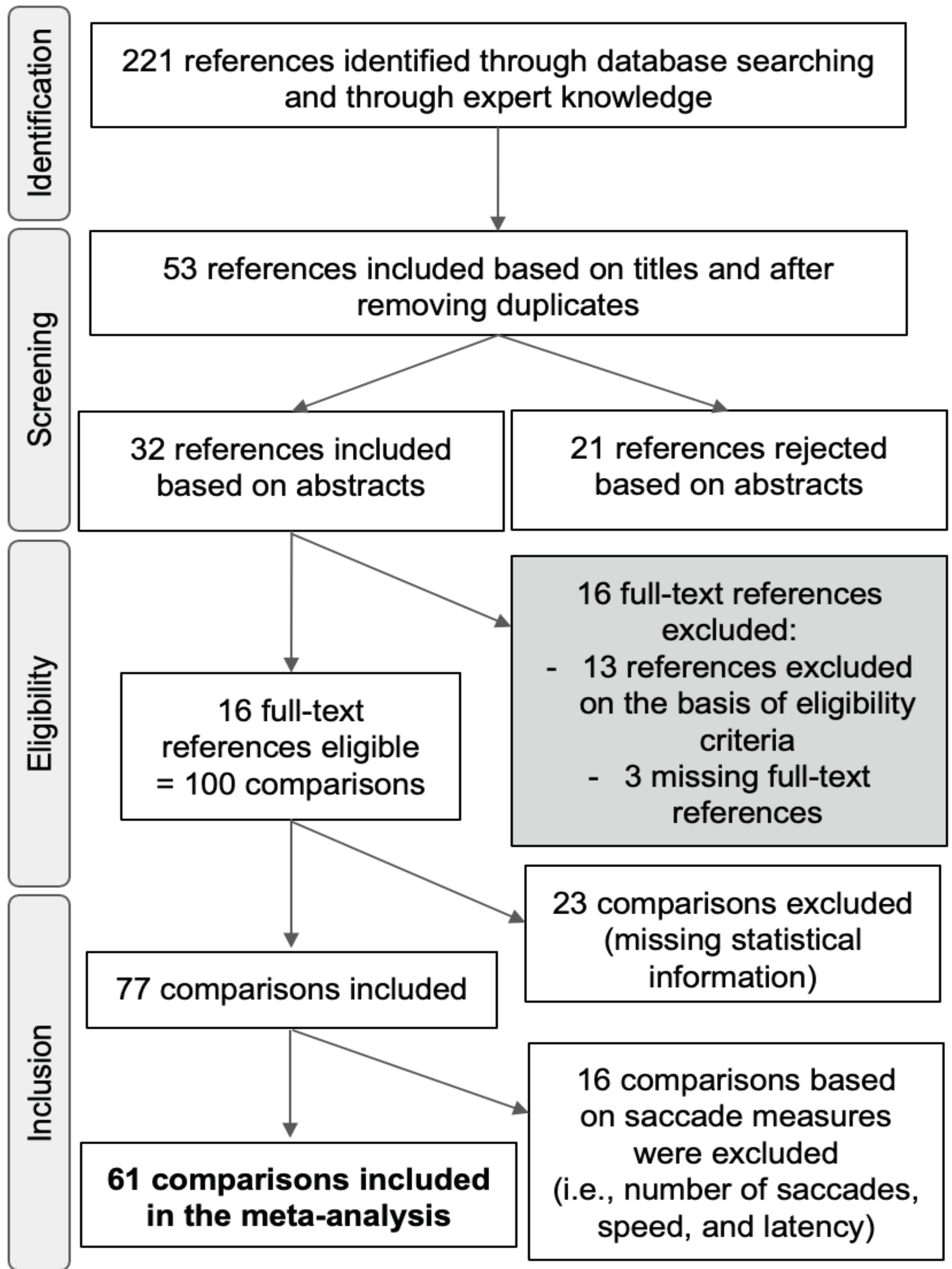
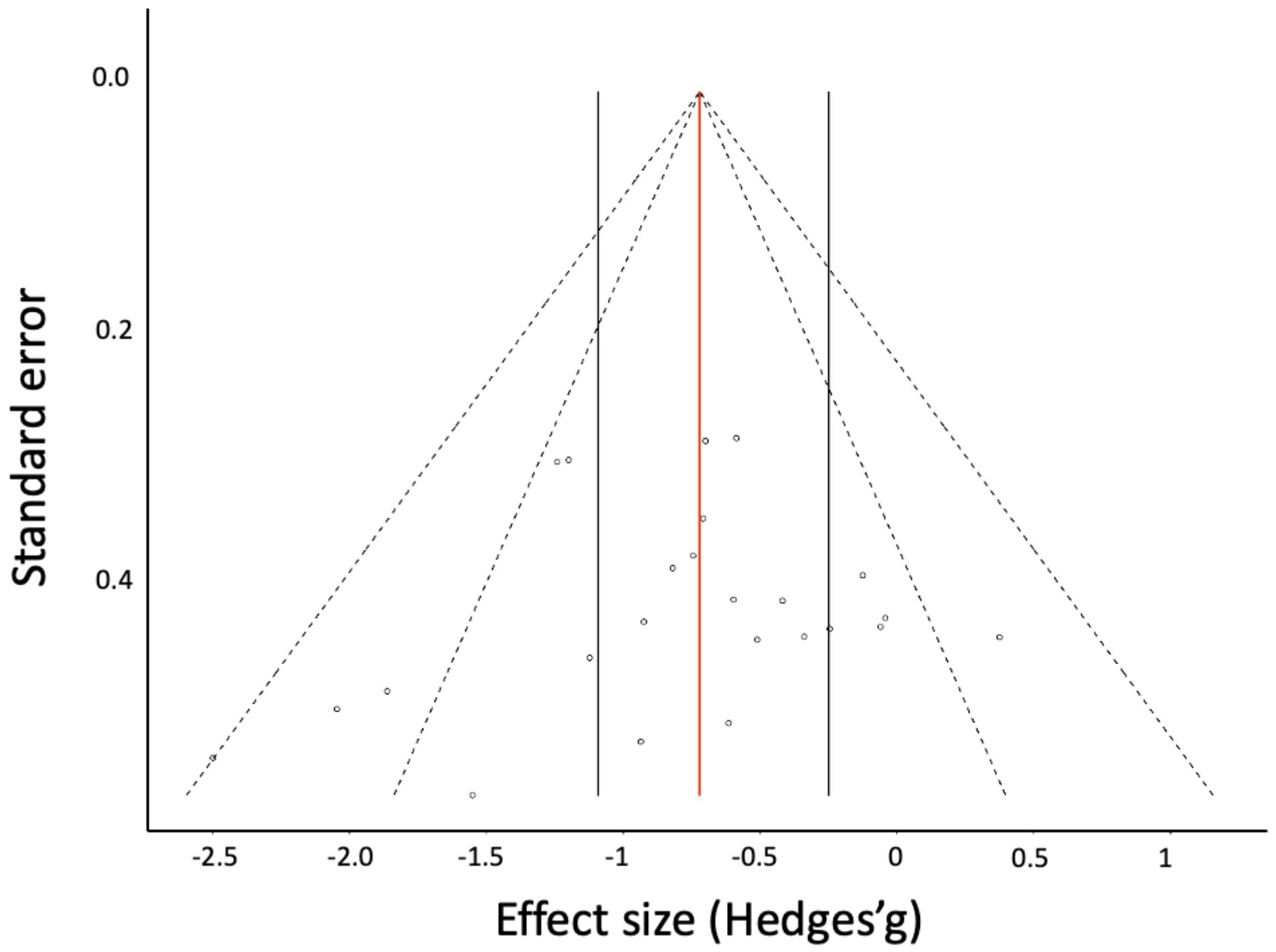
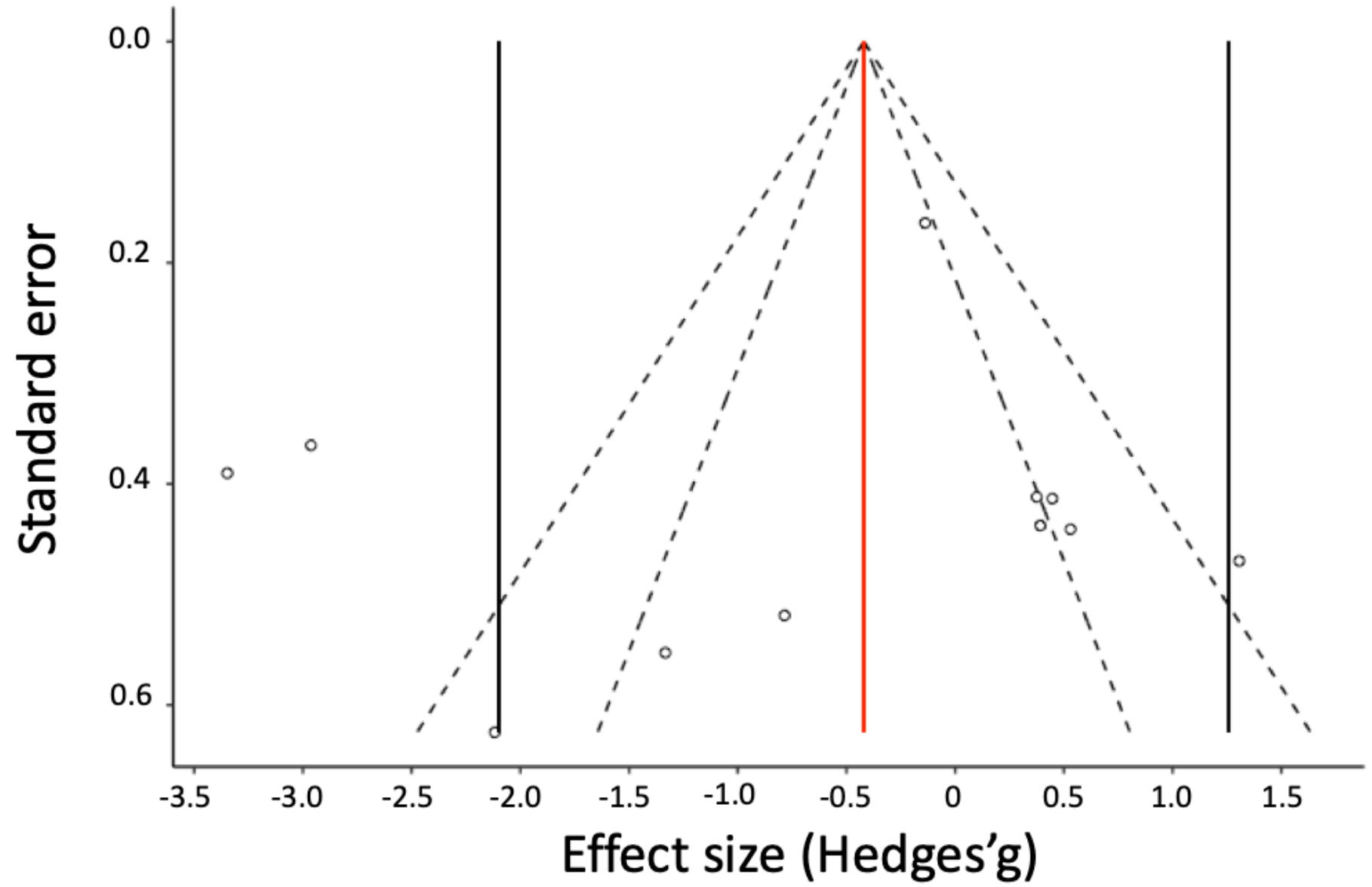




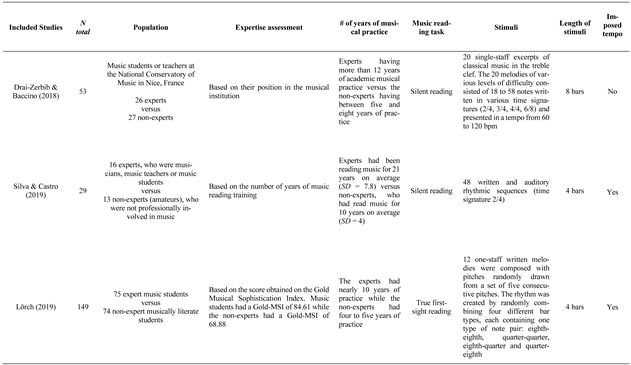


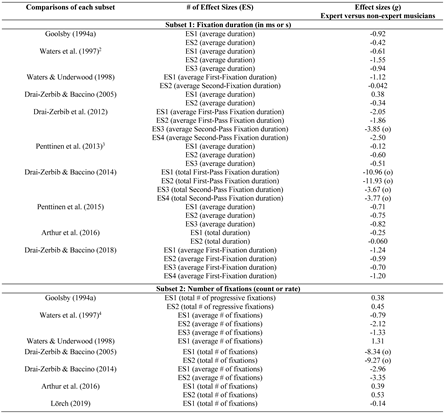
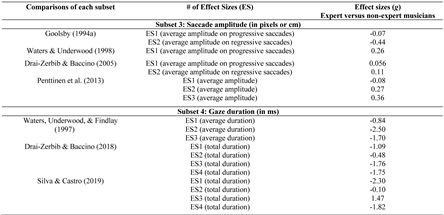

Disclaimer/Publisher’s Note: The statements, opinions and data contained in all publications are solely those of the individual author(s) and contributor(s) and not of MDPI and/or the editor(s). MDPI and/or the editor(s) disclaim responsibility for any injury to people or property resulting from any ideas, methods, instructions or products referred to in the content. |
© 2022 by the authors. This article is licensed under a Creative Commons Attribution 4.0 International License.
Share and Cite
Perra, J.; Latimier, A.; Poulin-Charronnat, B.; Baccino, T.; Drai-Zerbib, V. A Meta-Analysis on the Effect of Expertise on Eye Movements during Music Reading. J. Eye Mov. Res. 2022, 15, 1-33. https://doi.org/10.16910/jemr.15.4.1
Perra J, Latimier A, Poulin-Charronnat B, Baccino T, Drai-Zerbib V. A Meta-Analysis on the Effect of Expertise on Eye Movements during Music Reading. Journal of Eye Movement Research. 2022; 15(4):1-33. https://doi.org/10.16910/jemr.15.4.1
Chicago/Turabian StylePerra, Joris, Alice Latimier, Bénédicte Poulin-Charronnat, Thierry Baccino, and Véronique Drai-Zerbib. 2022. "A Meta-Analysis on the Effect of Expertise on Eye Movements during Music Reading" Journal of Eye Movement Research 15, no. 4: 1-33. https://doi.org/10.16910/jemr.15.4.1
APA StylePerra, J., Latimier, A., Poulin-Charronnat, B., Baccino, T., & Drai-Zerbib, V. (2022). A Meta-Analysis on the Effect of Expertise on Eye Movements during Music Reading. Journal of Eye Movement Research, 15(4), 1-33. https://doi.org/10.16910/jemr.15.4.1



